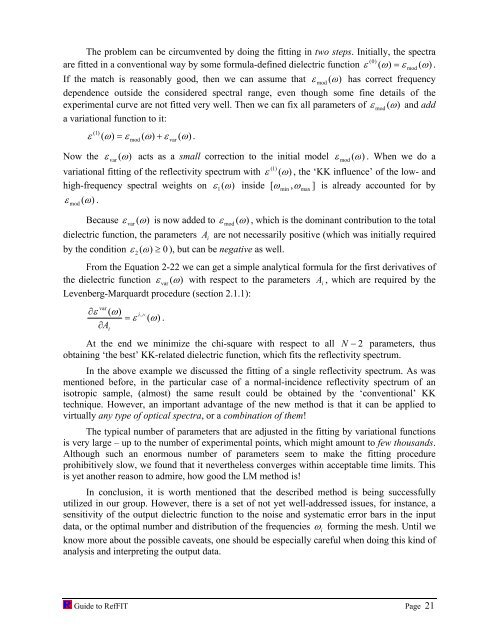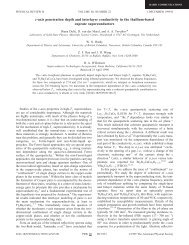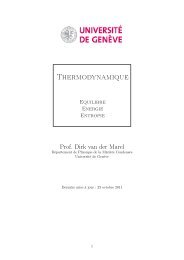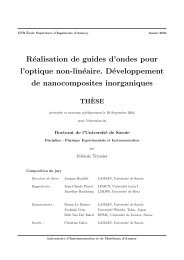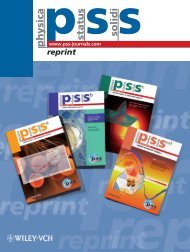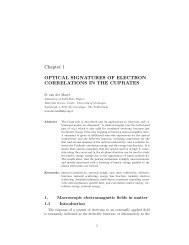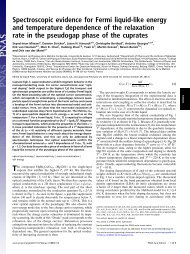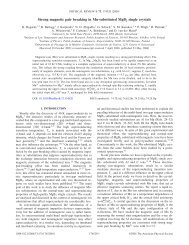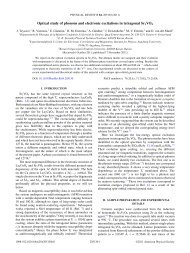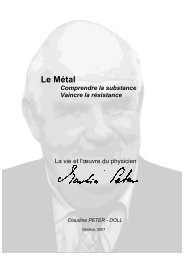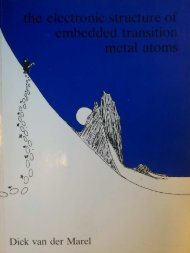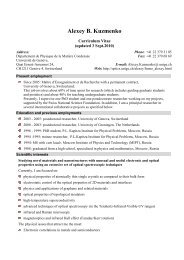software to fit optical spectra - Quantum Materials Group
software to fit optical spectra - Quantum Materials Group
software to fit optical spectra - Quantum Materials Group
You also want an ePaper? Increase the reach of your titles
YUMPU automatically turns print PDFs into web optimized ePapers that Google loves.
The problem can be circumvented by doing the <strong>fit</strong>ting in two steps. Initially, the <strong>spectra</strong><br />
( 0)<br />
are <strong>fit</strong>ted in a conventional way by some formula-defined dielectric function ε ( ω)<br />
= ε mod ( ω)<br />
.<br />
If the match is reasonably good, then we can assume that ε mod ( ω)<br />
has correct frequency<br />
dependence outside the considered <strong>spectra</strong>l range, even though some fine details of the<br />
experimental curve are not <strong>fit</strong>ted very well. Then we can fix all parameters of ε mod ( ω)<br />
and add<br />
a variational function <strong>to</strong> it:<br />
( 1)<br />
ε ω)<br />
= ε ( ω)<br />
+ ε ( ω)<br />
.<br />
( mod<br />
var<br />
Now the ε var ( ω)<br />
acts as a small correction <strong>to</strong> the initial model ε mod ( ω)<br />
. When we do a<br />
( 1)<br />
variational <strong>fit</strong>ting of the reflectivity spectrum with ε ( ω)<br />
, the ‘KK influence’ of the low- and<br />
high-frequency <strong>spectra</strong>l weights on ε 1( ω)<br />
inside [ ω min , ωmax<br />
] is already accounted for by<br />
ε ( ) .<br />
mod ω<br />
Because ε var ( ω)<br />
is now added <strong>to</strong> ε mod ( ω)<br />
, which is the dominant contribution <strong>to</strong> the <strong>to</strong>tal<br />
dielectric function, the parameters A i are not necessarily positive (which was initially required<br />
by the condition ε ( ω)<br />
≥ 0 ), but can be negative as well.<br />
2<br />
From the Equation 2-22 we can get a simple analytical formula for the first derivatives of<br />
the dielectric function ε var ( ω)<br />
with respect <strong>to</strong> the parameters A i , which are required by the<br />
Levenberg-Marquardt procedure (section 2.1.1):<br />
∂ε i ∧<br />
var<br />
( ω)<br />
,<br />
= ε<br />
∂A<br />
i<br />
( ω)<br />
.<br />
At the end we minimize the chi-square with respect <strong>to</strong> all N − 2 parameters, thus<br />
obtaining ‘the best’ KK-related dielectric function, which <strong>fit</strong>s the reflectivity spectrum.<br />
In the above example we discussed the <strong>fit</strong>ting of a single reflectivity spectrum. As was<br />
mentioned before, in the particular case of a normal-incidence reflectivity spectrum of an<br />
isotropic sample, (almost) the same result could be obtained by the ‘conventional’ KK<br />
technique. However, an important advantage of the new method is that it can be applied <strong>to</strong><br />
virtually any type of <strong>optical</strong> <strong>spectra</strong>, or a combination of them!<br />
The typical number of parameters that are adjusted in the <strong>fit</strong>ting by variational functions<br />
is very large – up <strong>to</strong> the number of experimental points, which might amount <strong>to</strong> few thousands.<br />
Although such an enormous number of parameters seem <strong>to</strong> make the <strong>fit</strong>ting procedure<br />
prohibitively slow, we found that it nevertheless converges within acceptable time limits. This<br />
is yet another reason <strong>to</strong> admire, how good the LM method is!<br />
In conclusion, it is worth mentioned that the described method is being successfully<br />
utilized in our group. However, there is a set of not yet well-addressed issues, for instance, a<br />
sensitivity of the output dielectric function <strong>to</strong> the noise and systematic error bars in the input<br />
data, or the optimal number and distribution of the frequencies ω i forming the mesh. Until we<br />
know more about the possible caveats, one should be especially careful when doing this kind of<br />
analysis and interpreting the output data.<br />
Guide <strong>to</strong> RefFIT Page 21


